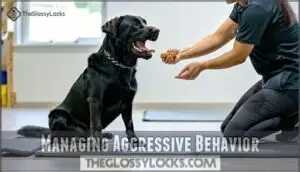This site is supported by our readers. We may earn a commission, at no cost to you, if you purchase through links.

That said, aggression can surface if they experience poor socialization, harsh treatment, or health issues. Like any dog, Labradors may display aggression out of fear, pain, or frustration.
Early training, proper socialization, and a calm environment can prevent most problems. If your Labrador seems unusually aggressive, it’s worth looking at possible stressors or medical causes.
Remember, a well-trained Labrador is usually a loveable, loyal companion. Curious about what might trigger aggression in a normally gentle breed?
Table Of Contents
- Key Takeaways
- Labrador Retriever Overview
- Are Labradors Aggressive
- Causes of Aggression
- Types of Aggression
- Factors Contributing to Aggression
- Managing Aggressive Behavior
- Preventing Aggression in Labradors
- Labrador Retriever Aggression Statistics
- Responsible Labrador Ownership
- Frequently Asked Questions (FAQs)
- Is it normal for labs to be aggressive?
- What is the 5 minute rule for Labradors?
- Do Labradors have behavior problems?
- What should I do if my Labrador is showing signs of aggression?
- How can I tell the difference between playful behavior and aggression?
- Are there any medical conditions that could cause aggression in Labradors?
- How can I use positive reinforcement to discourage aggressive behavior?
- Is there a particular age when Labradors are most likely to become aggressive?
- How do Labradors interact with other household pets?
- Can Labradors be protective of their owners?
- Conclusion
Key Takeaways
- Labradors aren’t usually aggressive, but fear, pain, poor socialization, or harsh treatment can trigger it.
- Early training, socialization, and avoiding physical punishment are key to preventing aggressive behavior.
- Watching for signs like growling or stiff posture helps you differentiate between playfulness and aggression.
- Seek professional help if needed, especially for sudden aggression that might signal health issues.
Labrador Retriever Overview
You might know Labradors as friendly and active dogs, but there’s more to their story. Originating in Newfoundland, they’ve gained fame worldwide for their versatility and lovable temperament.
Origin and History
The Labrador Retriever’s journey began in Newfoundland, Canada, not Labrador as you might think.
These working dogs nearly faced extinction in the 1880s but were saved by the Malmesbury family.
Recognized by the American Kennel Club in 1917, Labradors have risen to become America’s most popular breed.
Their breed temperament and characteristics made them favorites in Canada, England, and the United States, consistently ranking in the AKC’s top ten since the 1970s, with a breed temperament that is highly valued.
Physical Characteristics
The standard Labrador Retriever comes in three distinct coat varieties: black, yellow, and chocolate.
You’ll notice their sturdy build differences across genders, with males weighing 65-80 pounds and females 55-70 pounds.
All stand between 21.5-24.5 inches at the shoulder, and their dense, weather-resistant double coat and powerful body contribute to their 10-14 year lifespan.
Size standards vary slightly between American and English labrador breed characteristics, which can affect their overall build.
Temperament and Personality
While often described as the perfect family pet, Labrador Retrievers possess a temperament that’s consistently friendly, outgoing, and keen to please.
You’ll find these dogs are remarkably versatile, combining high energy levels with an affectionate nature.
Their trainability makes them excellent working dogs and companions, and breed standards emphasize their non-aggressive disposition, though individual Labrador traits can vary based on breeding and early experiences, making them highly versatile.
Are Labradors Aggressive
Despite their reputation as friendly family pets, you might wonder if Labradors can show aggressive behavior.
Labradors are beloved for their friendly nature, yet under certain circumstances, even they can exhibit unexpected aggressive behavior.
The truth is that any dog, regardless of breed, can display aggression under certain circumstances.
Labrador aggression isn’t common, but it does exist.
Studies show Labradors rank second nationwide for bite attacks at 13.72%, surprising many owners who believe their dogs wouldn’t hurt a fly.
Media portrayal often reinforces breed stereotypes, but labrador aggressive behavior typically stems from specific aggression triggers rather than inherent temperament.
These triggers might include fear, pain, resource guarding, or lack of proper training.
Legal ramifications of dog aggression can be serious, so understanding your Lab’s body language is essential.
Most Labradors aren’t naturally aggressive – they’re actually known for their gentle disposition.
With proper training and socialization, you’ll likely never witness problematic labrador behavior.
Causes of Aggression
You’ll find that your Labrador’s aggressive behavior often stems from early life experiences and improper training rather than natural temperament.
Understanding these root causes, from physical discomfort to lack of socialization, will help you address and prevent unwanted behaviors in your furry companion, by considering factors such as socialization.
Early Life Experiences
The critical fear imprint period (8-16 weeks) shapes your Labrador’s future behavior more than anything else.
Negative experiences during this window can trigger lifelong labrador aggressive behavior.
Early socialization plays a pivotal role in preventing puppy aggression, while family impact remains significant.
If your Labrador puppy shows anxiety, consistent positive discipline and secure affection will help manage potential labrador aggression rather than harsh corrections.
Physical Punishment
While early negative experiences shape a Lab’s behavior, physical punishment makes aggression worse, not better.
Using severe punishment creates a cycle of:
- Aggression escalation – your Lab may respond with increased hostility
- Fear induction – creating anxiety instead of respect
- Trust erosion – damaging your bond permanently
- Ineffective correction – failing to address the root cause
- Behavioral regression – teaching your dog that violence is acceptable
Instead of physical intervention or scolding, focus on positive reinforcement and consistent training methods to improve your Lab’s behavior and avoid damaging your relationship with them.
Neutering/Spaying
When considering neutering/spaying your Labrador, understand the timing impacts behavioral outcomes.
The procedure alters hormone levels, which can affect aggression in different ways.
Studies show mixed results—some Labradors experience aggression reduction after the surgery, while others may develop increased anxiety.
Veterinarians now recommend waiting until 12-18 months for ideal behavioral impact.
The connection between neutering/spaying and dog behavior varies with individual temperament and age considerations.
Pack Order Aggression
While Labradors establish social hierarchies within their pack, they may display dominance through growling, posturing, or resource guarding.
You’ll notice pack order aggression when your Lab challenges the hierarchy, especially during sibling rivalry situations.
This natural dog behavior typically emerges when dominant dogs feel their status is threatened, and it’s essential to recognize the signs of dominance and aggression.
Don’t physically intervene during these displays—instead, use proper intervention strategies to safely redirect without escalating aggression.
Types of Aggression
In the case of Labradors, aggression can show up in several specific ways, even though the breed is generally friendly.
Understanding these types of aggression can help you identify triggers and manage your dog’s behavior effectively.
Dog-to-Dog Aggression
Pack hierarchy plays a significant role in dog-to-dog aggression among Labradors.
Even these friendly retrievers can show signs of resource guarding or leash reactivity when encountering other dogs.
You’ll notice this behavior stems from their natural instinct to establish dominance.
Proper socialization from puppyhood helps prevent aggressive behavior toward other canines.
If your Lab growls or lunges at other dogs, don’t panic—this common issue can be addressed with consistent training.
Dog-to-Human Aggression
Though generally friendly, your Labrador can show dog-to-human aggression when they feel intimidated or experience physical intervention.
This behavior isn’t typical of the breed but requires immediate attention, especially regarding child safety.
Prevention strategies include recognizing warning signs, avoiding confrontational training methods, and understanding bite severity scales.
Never punish an aggressive Labrador—this only reinforces their fear.
Instead, address underlying labrador behavior problems with positive reinforcement and professional guidance when needed.
Redirected Aggression
Many Labradors experience redirected aggression when they can’t reach the actual target of their frustration. You’ll notice your Lab shifting their aggression from the original trigger to a more accessible target—often a subordinate family member or child.
- Target identification helps prevent these incidents
- Children are particularly vulnerable to redirected aggression
- Trigger displacement commonly occurs during dog fights
- Prevention tactics include separating your Lab from potential targets
When frustrated or aroused, your otherwise friendly Labrador might redirect their aggression toward whoever is nearest. Understanding this behavior is vital for everyone’s safety.
Territorial Aggression
While redirected aggression shifts target, territorial aggression in Labradors focuses on defending what they consider theirs.
Your Lab might show aggressive behavior when strangers approach your home or yard – their defined territory. This isn’t uncommon, as dogs naturally guard resources.
Early prevention through consistent dog training techniques can manage these instincts before they become problematic. Without intervention, territorial aggression may have serious legal ramifications if your pet feels their space is threatened, leading to potential issues with legal ramifications.
Factors Contributing to Aggression
You’ll find that your Labrador’s aggression isn’t random but stems from specific factors including early experiences, anxiety, poor socialization, and genetics.
Understanding these root causes helps you address unwanted behaviors before they become serious problems.
Anxiety and Fear
Anxiety and fear can transform your normally friendly Labrador into a reactive companion.
Anxiety and fear can turn even the gentlest Labrador into a reactive companion, highlighting the importance of building their confidence early.
Your Lab may develop fear-induced aggression when feeling threatened or cornered.
Fear triggers often include sudden movements, unfamiliar people, or previous negative experiences.
When anxious, Labs display warning signs like yawning, turning away, or dilated pupils before escalating to dog-to-human aggression.
Addressing these underlying emotions through anxiety management and confidence building is key to preventing reactive behaviors.
Socialization and Training
Fear in Labradors can trigger defensive behaviors.
Proper socialization and training directly impact your Labrador’s temperament and ability to handle stressful situations.
Early socialization between 8-16 weeks is critical – this period shapes how your dog will react to new experiences.
Consistent training methods focusing on impulse control and reactivity management prevent aggression development.
Without these foundations, even friendly Labradors may develop problematic behaviors when faced with unfamiliar scenarios or perceived threats.
Genetics and Breeding
Genetic predisposition plays a minor role in Labrador aggression, but responsible breeding focuses on temperament selection and lineage influence to reduce risks.
Genetics shape breed traits like friendliness, not hostility. Health screening guarantees better Labrador temperament by avoiding genetic tendencies tied to illness or pain, which might spur aggression.
Proper breeding preserves the friendly, affectionate nature Labradors are celebrated for, ensuring they remain a breed known for their friendly characteristics.
Environmental Factors
Your Labrador’s surroundings play a big role in shaping behavior. A stable home environment, varied exposure, and consistent training reduce labrador aggressive tendencies.
Keep these in mind:
- Make certain early socialization to foster positive dog-human interaction.
- Provide resources like toys to prevent resource-guarding.
- Promote balanced social interactions with other pets and people.
Nurturing these factors curbs aggression and strengthens your bond. A stable environment is key to preventing aggression.
Managing Aggressive Behavior
If your Labrador shows signs of aggression, managing their behavior starts with understanding the triggers and using the right methods.
With consistent positive reinforcement, training, and expert guidance, you can help your dog feel more secure and confident.
Positive Reinforcement Training
Positive reinforcement is key to shaping behavior and fostering the Labrador temperament.
Reward timing matters—deliver treats or praise immediately to reinforce good actions.
Consistency is just as important, so stick to the same dog training techniques daily.
Clicker training is a helpful method, and understanding motivation levels can keep Labradors engaged.
High-value rewards like positive reinforcement treats can substantially improve training outcomes.
Patience turns labrador training into a rewarding journey for both, making positive reinforcement and consistency essential elements.
Desensitization and Counterconditioning
To address dog aggression, desensitization and counterconditioning focus on gradual exposure to triggers.
Pair those situations with positive associations, like favorite treats, to reshape emotional responses. Consistent application is essential—small, repeated steps create progress.
If you’re unsure, seek professional guidance for customized behavior modification plans. Many owners find success using treats for anxious dogs during this process.
This method helps your dog feel safe around triggers, reducing unwanted reactions effectively, through counterconditioning and positive associations with items like favorite treats.
Behavior Adjustment Therapy
Behavior Adjustment Therapy (BAT) helps manage dog aggression by fostering calm responses.
BAT techniques focus on gradual exposure to triggers, keeping stress low.
Negative reinforcement in behavior modification means dogs learn to avoid stress by behaving calmly.
Expert implementation guarantees safety and arousal management.
While BAT limitations exist, working with an animal behaviorist enhances dog training and promotes lasting change.
Professional Help and Guidance
Sometimes aggression needs a professional touch. An animal behaviorist or veterinary behaviorist can unravel the “why” behind actions and create customized training programs.
Expert help provides:
- Behavior modification plans to address triggers effectively.
- Medication options when anxiety or health is a factor.
- Support groups for shared experiences and guidance.
Don’t wait—aggression often worsens without focused dog aggression management.
Preventing Aggression in Labradors
You can prevent aggression in Labradors by focusing on proper socialization, early training, and consistent discipline.
Monitoring their health and providing mental stimulation are also essential to guarantee a well-adjusted, balanced dog.
Proper Socialization
Start socializing your Labrador early to prevent aggression. Puppy socialization builds confidence, while adult socialization reinforces good behavior.
Introduce them to noises, people, and other pets gradually using socialization methods. Challenges, like fear or hesitation, can arise, but patience helps.
Socialization benefits include improved adaptability and reduced anxiety. Early life experiences shape behavior, making proper labrador socialization essential for a balanced, friendly dog.
Early Training and Discipline
Early socialization sets the stage, but teaching bite inhibition and puppy obedience is your next step.
Encourage positive discipline with crate training and leash manners. Labrador puppy biting is normal, but guide them gently—it’s not a free-for-all.
Focus on building strong social skills through productive dog training. To further protect your furry friend, consider that regular grooming prevents breakage.
Remember, early training shapes a well-mannered companion for life, and with proper care, such as regular grooming, you can prevent issues like hair breakage, ensuring your dog’s overall health and well-being.
Monitoring Behavior and Health
Keep an eye on your Labrador’s behavioral patterns to catch aggression triggers early.
Medical problems like pain or illness often worsen aggressive behavior, so a timely medical evaluation is essential.
Pain management and a balanced diet can help reduce irritability, and exercise needs impact mood too—regular activity prevents frustration.
Address genetic disposition calmly and seek professional guidance when issues arise.
Providing Mental Stimulation
Labrador Retrievers thrive with mental stimulation to prevent problem behaviors.
Use puzzle toys and training games to challenge them. Scent work taps into their natural abilities, while social interaction keeps them sharp.
Rotate toys regularly to maintain interest. Consider using stimulating puzzle options to keep your Labrador engaged.
Meeting their exercise needs and engaging in thoughtful dog training build a well-rounded, happy companion with fewer chances for aggressive dog behavior and provide a good environment for happy companion.
Labrador Retriever Aggression Statistics
You might think Labradors are always gentle, but statistics reveal a more complex picture. Understanding bite rates and comparing them with other breeds helps you assess their risk more accurately.
Bite Attack Rates
Although Labradors are one of the least aggressive breeds, they rank second nationally with a 13.72% bite rate, trailing pit bulls.
Their size, popularity, and adaptability explain this frequency more than innate aggression. Biting incidents often occur in homes, parks, or neighborhoods.
Here’s a quick comparison:
The national rankings and bite severity are important factors to consider when evaluating dog breeds. Pit bulls have a higher bite severity, while Labradors have a higher breed popularity.
Fatal Dog Attacks
Sadly, Labradors have been involved in rare fatal dog attacks, though their temperament is generally friendly. Most cases reflect specific attack circumstances or improper handling.
Male dogs cause over 90% of fatal incidents, highlighting victim demographics like children.
| Factor | Labrador Stats (%) | General Insights |
|---|---|---|
| Bite Involvement | 13.72 | Second highest |
| Male Dogs in Fatalities | 90+ | Gender plays key role |
| Prevention Strategies | Essential | Early socialization helps |
Effective prevention strategies and understanding Labrador bite risks can save lives, emphasizing the importance of early socialization.
Breed Comparison and Analysis
While fatal attacks are rare, comparing Labrador aggression to other dog breeds highlights differences in temperament traits and bite statistics.
Labradors excel in training success and family adaptability.
Here’s a look at popular breeds:
| Breed | Temperament Traits | Bite Statistics |
|---|---|---|
| Labrador | Friendly, loyal | 13.72% in U.S. |
| Golden Retriever | Gentle, calm | Rarely reported |
| German Shepherd | Protective, intelligent | Higher than average |
Understanding breed characteristics guarantees informed ownership.
Responsible Labrador Ownership
Owning a Labrador means taking responsibility for their physical and emotional needs to keep them happy and well-behaved.
By providing proper training, supervision, and care, you can help prevent potential behavioral issues like aggression.
Supervising Interactions With Children
When handling Labrador aggression, supervising playtime is non-negotiable for child safety.
Even gentle dogs can react unpredictably if teased or approached during feeding. Teach kids to respect boundaries and avoid rough or sudden movements.
Safe interactions mean never leaving young children unsupervised, especially with unfamiliar dogs.
Bite prevention starts with calm, respectful behavior and knowing when to step in, which is crucial for ensuring child safety.
Providing Adequate Exercise and Stimulation
Labradors thrive on daily exercise and mental stimulation to prevent boredom and destructive behaviors.
Regular walks, training games, and fun activities like fetching or swimming meet their high exercise needs.
Mental enrichment, like puzzles or scent games, is essential for this energetic Labrador dog breed.
A tired dog is a happy dog—so keep them active and challenged to guarantee their well-being.
Addressing Health Issues and Anxiety
Addressing a Labrador’s health issues and anxiety is essential for preventing aggression. Health problems, like pain-induced aggression, need prompt medical evaluation and pain management. Anxiety triggers, such as fear-induced aggression, improve with secure affection and positive discipline.
Monitor for signs of discomfort and act early. Guarantee regular vet checkups. Create a safe, calm environment. Address medical issues immediately.
Build trust through gentle care.
- Guarantee regular vet checkups.
- Create a safe, calm environment.
- Address medical issues immediately.
- Build trust through gentle care, ensuring a secure and affectionate relationship.
Seeking Professional Help When Needed
When things feel out of hand, turning to professionals can make all the difference.
Behavioral veterinarians or certified trainers offer customized dog training advice and medication options for severe cases.
You’ll know when to seek help if short-term fixes fail or aggression worsens.
Dog training resources from animal behavioralists or a skilled dog behaviorist provide valuable long-term management strategies.
Frequently Asked Questions (FAQs)
Is it normal for labs to be aggressive?
Picture gentle giants wagging tails, but even Labs can show aggression, though it’s rare.
Often, it reflects fear, pain, or poor training.
Early socialization, proper care, and understanding their needs keep these lovable pups balanced.
What is the 5 minute rule for Labradors?
The 5-minute rule for Labradors suggests limiting intense exercise for puppies to 5 minutes per month of age, twice daily.
This protects their growing joints from injury while allowing safe, gradual development.
Do Labradors have behavior problems?
Imagine a high-energy toddler needing constant attention—Labradors, like them, thrive with structure.
Without mental stimulation and exercise, they may develop issues like excessive barking, chewing, or digging, but proper training keeps them balanced and happy.
What should I do if my Labrador is showing signs of aggression?
If your Labrador shows aggression, stay calm, identify the triggers, and avoid punishment.
Use positive reinforcement, seek advice from a professional trainer or behaviorist, and guarantee proper exercise and mental stimulation to address underlying issues.
How can I tell the difference between playful behavior and aggression?
Look for body language.
Playful behavior includes wagging tails, relaxed ears, and bouncy movements.
Aggression shows stiff posture, growling, raised hackles, or a fixed stare.
Context and your dog’s history help differentiate the two, using complete concepts to understand their behavior.
Are there any medical conditions that could cause aggression in Labradors?
Certain medical conditions like hip dysplasia, arthritis, brain tumors, or thyroid imbalances can cause aggression in Labradors.
Pain or hormonal changes often trigger irritability, so always consult a vet if aggression seems sudden or unusual.
How can I use positive reinforcement to discourage aggressive behavior?
Reward calm behavior with treats, praise, or play.
Redirect aggressive triggers by teaching alternative actions like sitting.
Consistency, patience, and positive reinforcement reshape responses over time, creating a confident, well-behaved Labrador while avoiding punishment-based approaches.
Is there a particular age when Labradors are most likely to become aggressive?
Around 72% of dog bites in the U.S. involve Labradors.
They’re most prone to aggression during their “teenage” phase, 6–18 months, due to hormonal changes, energy spikes, and a lack of training or socialization.
How do Labradors interact with other household pets?
Labradors generally get along well with other household pets due to their friendly and social nature.
Proper introductions, early socialization, and supervision help guarantee smooth interactions, reducing the chance of misunderstandings or dominance issues, which is crucial for socialization.
Can Labradors be protective of their owners?
Yes, they can be protective of their owners, but not in an aggressive way.
They’re more likely to use their loyalty and friendly nature to alert you to danger rather than act as guard dogs.
Conclusion
While Labradors are beloved for their friendly nature, the question remains: are Labradors aggressive?
The answer largely depends on their environment, training, and experiences. With proper socialization, patience, and care, they’re typically affectionate and loyal companions.
However, neglecting their needs or ignoring stressors can lead to behavioral issues. Address any signs of aggression early, consult professionals when necessary, and remember that your Labrador thrives in a positive, balanced environment.
With guidance, they’ll remain the gentle dogs we cherish.
- https://www.npr.org/2021/03/16/977895473/the-most-popular-dog-breeds-of-2020-labs-and-french-bulldogs
- https://www.akc.org/expert-advice/news/americas-record-setting-dog-versatility-temperament/
- https://studyfinds.org/seeing-eye-dogs/
- https://www.denverpost.com/2009/02/26/dog-bite-survey-finds-few-canines-that-attack/
- https://maho-prentice.com/blog/2021/11/dog-bite-statistics-by-breed-2021/

















